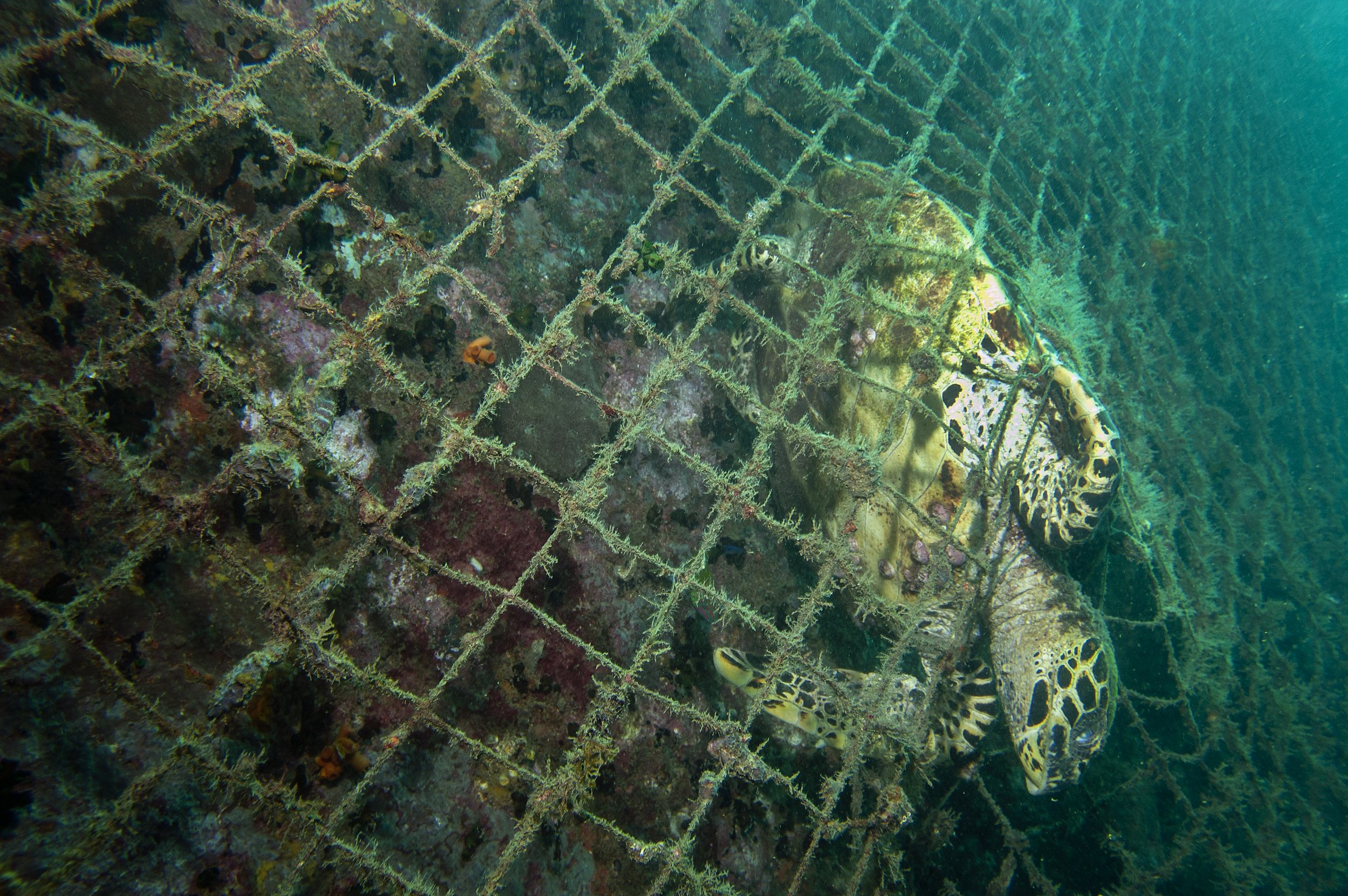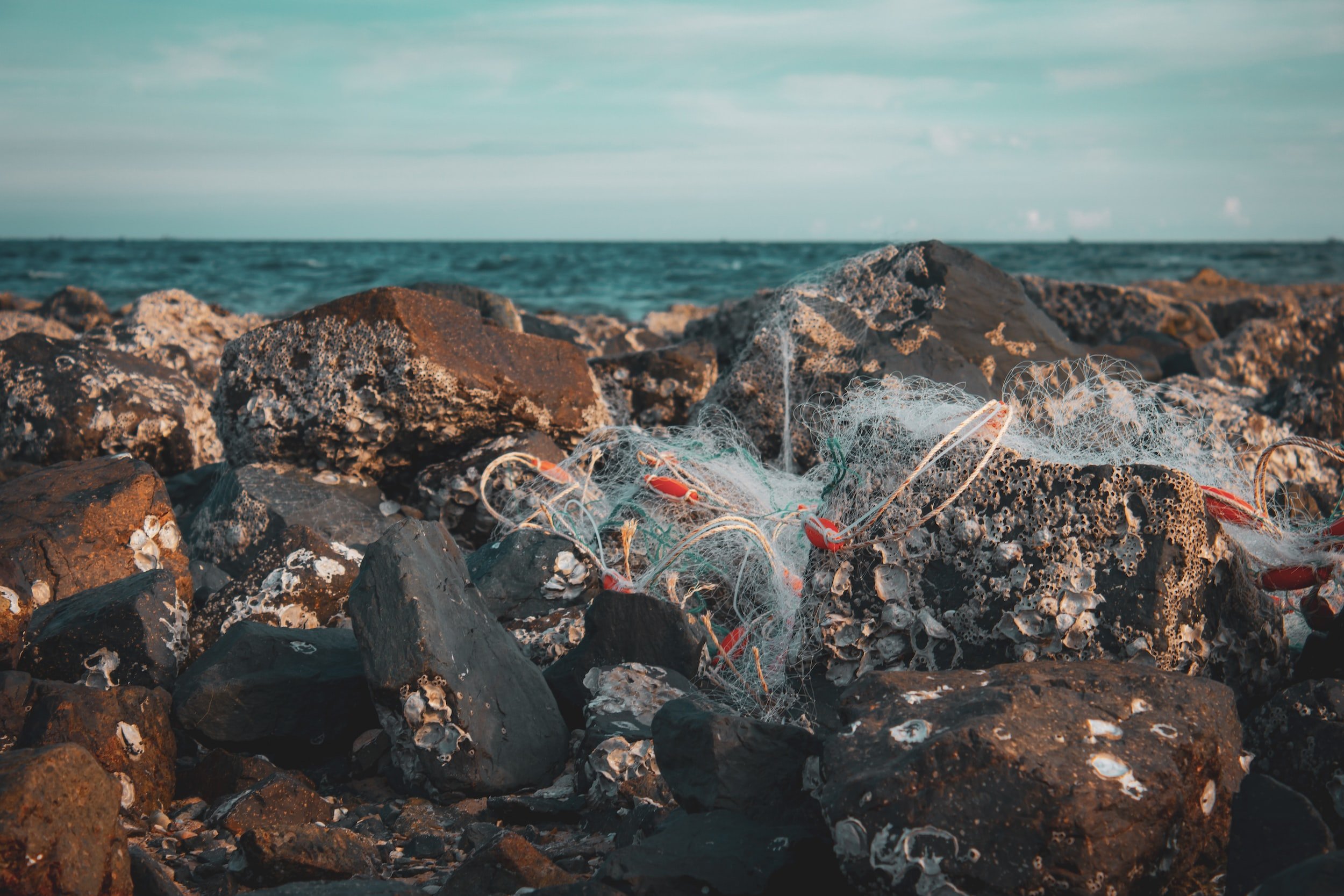ghost gear
If you walk along any beach in the world you are bound to find broken down remnants of abandoned, lost or otherwise discarded fishing gear (ALDFG). Dive down to the seabed and larger nets can be found snagged on rocks, covering reefs or entangled in seaweed. According to the Food and Agricultural Organization of the United Nations (FAO), at least 640,000 tonnes of fishing gear is thought to be lost or abandoned in the ocean every year. It makes up about 10% of all marine debris and is by far the most harmful form of debris because the nets continue to catch fish and trap marine mammals for decades after they have entered the marine environment, thus the name ghost fishing.
Since industrial production of plastic began in the 1950s, the fishing industry has embraced its use for ropes, nets and lines. Many qualities of plastic make it ideal for this use: it is cheap, light, buoyant and durable, perfect for the fishing industry. But if lost at sea, plastic's durability means it can continue to fish even if no longer operational and when it breaks up into tiny pieces these remain in the marine environment indefinitely.
Fishing gear is lost for many reasons, but most commonly occurs when gear catches on reefs or rocks, gets tangled with other fishers’ gear, or washes away during severe weather. In some cases, it is also abandoned intentionally by those fishing illegally to evade capture or to avoid being denied entry to port.

Toby Matthews/Ocean Image Bank

Umeed Mistry/Ocean Image Bank

Holly Richards/USFWS

Đoàn Xuân Phương/Unsplash
Studies conducted in the Pacific show that ghost gear makes up approximately 86% of the floating macroplastic (with a length of more than 50cm) found in the Great Pacific Garbage Patch. A 2019 study (Estimates of fishing gear loss rates at a global scale: A literature review and meta-analysis) estimated that 5.7% of all fishing nets, 8.6% of all traps, and 29% of all lines are lost around the world each year. Let's look at this last figure and consider its impact: longlines are generally used for pelagic (midwater) or demersal (bottom) fishing, often to catch tuna or sharks. They consist of one main fishing line with other lines branching off, each of which ends with a hook with bait. The lines can be up to 100 kilometres in length with 2 to 3,000 other lines branching off. If 29% of all longlines are lost a year, that means that thousands of kilometres of unrecovered longlines are left floating in the ocean, continuing to attract fish to the baited hooks until they sink to the ocean floor where they can entrap deep sea species. Over decades these break up into smaller particles, or microplastics, bringing a further array of problems to the marine environment.
What are we doing about it?
Recognition of ghost gear as a threat to the marine environment only really developed in the 1980s but since then the adverse effects of ghost gear have been brought to the world’s attention with photographs of ensnared seals, turtles and even whales making the news. It is thought that millions of marine species are injured or killed by ghost gear each year: marine life which gets entangled in the gear can be injured or their mobility impacted, as a consequence the animal may face difficulties feeding and reproducing and may die.
Once lost, the gear is moved around the ocean by the currents, waves and wind. In so doing it can destroy marine habitats, preventing them from supporting marine life as they should: a damaged coral reef for example will no longer function as an effective nursery and feeding ground for many marine species.
In an attempt to prevent or deter the deliberate abandonment of fishing gear, the FAO has established a set of Voluntary Guidelines on the Marking of Fishing Gear and sets out a number of measures and proposals to fight ghost gear, which include:
marking the gear to enable identification of ownership and encourage responsible management of fishing gear;
improving reporting and recovery of lost gear with a "no-blame" approach and an incentivised retrieval scheme so that vessels bring back any lost gear found at sea;
stopping illegal fishing;
giving economic incentives to recycle end-of-life fishing gear and return gear to recycling facilities;
installing transponders on gear to be tracked by Global Positioning Systems (GPS) to make retrieval easier; and
improving reception facilities for collection, disposal and recycling at ports.
Reception facilities for fishing gear in ports and a change of attitude towards recycling the gear are of upmost importance in combatting ghost gear. If fishers try not to lose further gear and are provided with an incentive to collect any gear that they find, some progress can be made in both preventing further pollution of this kind and clearing the ocean of surface ALDG. In terms of recycling the gear, there are many solutions for recovered ghost nets: thinner nylon nets can be spun into yarn and used for clothing or bags while the thicker nets used for trawling can be melted down into pellets and then reused in a wide variety of products.
The OECD Environment Policy Paper No. 25 “Toward G7 Action to Combat Ghost Fishing Gear” was prepared as a background document for G7 Climate and Environment Ministers under the G7 Presidency of the United Kingdom in 2021. The report reviews current policy efforts at the international level and in G7 countries, proposes a series of priority actions that G7 countries could take in order to lead the way in addressing the ghost gear challenge and recommends a comprehensive policy response through international co-operation and circular economy approaches.
Spotlight on the Global Ghost Initiative
The Global Ghost Initiative (GGGI) was established in 2015 as a cross stakeholder alliance of representatives from the fishing industry, private sector, corporates, NGOs, academia and governments, working to solve the problem of lost and abandoned fishing gear worldwide.
According to their website, GGGI supports multiple projects around the world in a multifaceted approach:
identifying and monitoring ghost gear: the GGGI App and the GGGI data portal provide platforms for data collection, helping to establish a global baseline of data on ghost gear around the world;
recovering ghost gear: GGGI supports a variety of projects in their recovery of ALDG such as the Myanmar Ocean Project. Gear is generally recovered by divers using cutting instruments and float bags to lift retrieved gear to the surface;
recycling ghost gear: GGGI works with projects involved in recycling such as the Net Regeneration Scheme in the United Kingdom, which provides collection points and free net recycling solutions for gear generated and recovered by the fishing industry, and the Net Positiva project in Chile, which recycles nets to make skateboards;
marking gear: GGGI runs programmes working with fishers where methods for marking and tracking fishing gear (nets or artisanal fish aggregating devices, both anchored and drifting devices), such as in the South Pacific;
shaping policy: GGGI has established policy for both fisheries and aquaculture sectors, the Best Practice Framework for the Management of Fishing Gear (C-BPF) and the Best Practice Framework for the Management of Aquaculture Gear (A-BPF) and an Analysis of Ghost Gear Legislation together with the WWF, Ocean Outcomes and Ocean Conservancy.
providing capacity building: through workshops to train divers (such as in Panama), to inform fisher communities and develop best practices for addressing the problem, avoid further pollution, and help them to use the recovered materials (such as in Nigeria).
The GGGI report, Effective Ghost Gear Solutions, put together with the WWF and Ocean Conservancy, sets out their vision for preventing, mitigating and curing the problem. GGGI introduce their work here:

